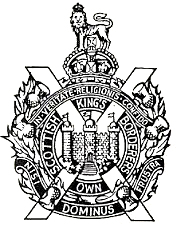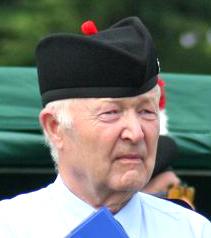 In this excerpt writer Alistair Aitken examines the origins and history of three regiments, the The Royal Scots, the King’s Own Scottish Borderers and the Seaforth Highlanders…..
In this excerpt writer Alistair Aitken examines the origins and history of three regiments, the The Royal Scots, the King’s Own Scottish Borderers and the Seaforth Highlanders…..
The Seaforths were officially formed in 1881 when the 78th Highlanders (Ross-shire Buffs) and 72nd Highlanders (Duke of Albany’s Own) Regiments of Foot were amalgamated as a result of the Childers Reforms, although its history can be traced back at least 100 years before that. It was based at Fort George, near Inverness, for most of its life, but the Seaforth Highlanders served in Britain’s colonial wars in Egypt (1882), the Sudan (1885), India (1895) and the Boer War (1899-1902).
 At the outbreak of World War I the 1st Battalion was serving in India and the 2nd Battalion was based at Shorncliffe Camp in Kent, England, when it was sent to France as part of the British Expeditionary Force. It was involved in the retreat from Le Cateau, the Battle of the Marne and the Battle of the River Aisne. The 1st Battalion was posted to France in late 2014 and took part in the Battle of Givenchy. During the War the three front line Territorial Battalions all served in the 51st (Highland) Division.
At the outbreak of World War I the 1st Battalion was serving in India and the 2nd Battalion was based at Shorncliffe Camp in Kent, England, when it was sent to France as part of the British Expeditionary Force. It was involved in the retreat from Le Cateau, the Battle of the Marne and the Battle of the River Aisne. The 1st Battalion was posted to France in late 2014 and took part in the Battle of Givenchy. During the War the three front line Territorial Battalions all served in the 51st (Highland) Division.
In 1921 the 1st Battalion was deployed to the Scottish coalfields to maintain order during strike action by the miners. The battalion subsequently served in Ireland during and after the partition. The 1st Battalion returned to India in the late 1920s and both battalions served in Palestine in the 1930s.
 During World War II the 6th Battalion was sent to France as part of the British Expeditionary Force. In May 1940 they escaped through Dunkirk. The 2nd and 4th Battalions were also part of the British Expeditionary Force in 1940, serving in the 51st (Highland) Division many of whom were captured at St Valery. The Seaforth Highlanders served with distinction as part of 152 Brigade from El Alamein onwards until the German surrender in Sicily. Subsequently 152 Brigade joined the D-Day campaign in 1944 and served continuously until the capture of Bremen and VE-Day. The 7th Battalion Seaforths also served in North West Europe with the 15th (Scottish) Division in 1944.
During World War II the 6th Battalion was sent to France as part of the British Expeditionary Force. In May 1940 they escaped through Dunkirk. The 2nd and 4th Battalions were also part of the British Expeditionary Force in 1940, serving in the 51st (Highland) Division many of whom were captured at St Valery. The Seaforth Highlanders served with distinction as part of 152 Brigade from El Alamein onwards until the German surrender in Sicily. Subsequently 152 Brigade joined the D-Day campaign in 1944 and served continuously until the capture of Bremen and VE-Day. The 7th Battalion Seaforths also served in North West Europe with the 15th (Scottish) Division in 1944.
Probably the regiment’s most famous pipers were P/Ms Donald MacLeod and Donald MacLean, pictured above during WW2 (seated centre left and centre respectively). The regiment always had a strong piping tradition and produced a popular book of tunes which is still in common use.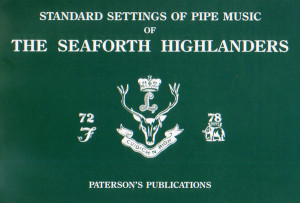
In 1961, as part of the Defence Review, the Seaforth Highlanders were amalgamated with the Cameron Highlanders to form the Queen’s Own Highlanders. Since 2006 The Highlanders have been known as 4 SCOTS The Highlanders.
The Royal Scots, the oldest infantry regiment in the British Army, was formed in 1633, when Sir John Hepburn raised a body of men for service in France under a Royal Warrant granted by King Charles 1. By 1635 the regiment comprised over 8,000 men, including many who had fought as mercenaries in the 'Green Brigade' for King Gustavus Adolphus of Sweden. In 1661 the regiment became the original model for others when it was summoned to Britain to bridge the gap between the disbandment of the New Model Army and the creation of a Regular Army. In 1680 the regiment was sent to Tangier, where it won its first battle honour. On its return to England in 1684 the title 'The Royal Regiment of Foot' was conferred by Charles 11.
During the 1700s the regiments saw service from Canada to the West Indies. During the Napoleonic Wars the regiment was expanded to four Battalions, with service in Egypt, the West Indies, India and Europe. The 3rd Battalion saw action at Corunna in 1808 and then took part in the Peninsular War, and the Battles of Quatre Bras and Waterloo. The 1st and 2nd Battalions then saw action in India between 1817 and 1831, followed by the Crimean War and the Boer War. World War 1 saw the Battalions increased to 35, of which 15 served as active front line units. The active service Battalions were also involved in areas from the Western Front to the Dardanelles, Macedonia, Egypt and North Russia. 71 Battle Honours and six VCs were awarded to the regiment during this time. Battalions subsequently served in Ireland, Egypt, Burma, China and the North West Frontier. At the start of World War 2 the 1st Battalion served in France and was forced to retreat with heavy casualties at Dunkirk. The 2nd Battalion saw action against the Japanese in Hong Kong. After Dunkirk the reconstituted 1st Battalion took part in the Arakan campaign in Burma in 1943 and the Battle of Kohima in 1944. A new 2nd Battalion formed in 1942 served in Italy and Palestine whilst the 7th/9th and 8th Battalions fought in Europe after D-Day. Since 1945 the regiment has served in Germany, Korea, Cyprus, Suez, Aden and Northern Ireland. The regiment celebrated its 350th Anniversary in 1983. In 1990 the 1st Battalion was deployed to Saudi Arabia as an armoured infantry battalion to take part in the Gulf War. Since that time it has also served in Bosnia and Iraq.
 Like the other Scottish regiments the Pipes and Drums of The Royal Scots comprised serving soldiers and through the years the pipe bands have featured in many military and public ceremonial occasions. Some of the early players in the Colinton and Currie Pipe Band, near Edinburgh, served in The Royal Scots; and it is known that the C&CPB rope tension Bass Drum, which is now on display in the museum at RSPBA Headquarters in Glasgow, was played in The Royal Scots during World War 1.
Like the other Scottish regiments the Pipes and Drums of The Royal Scots comprised serving soldiers and through the years the pipe bands have featured in many military and public ceremonial occasions. Some of the early players in the Colinton and Currie Pipe Band, near Edinburgh, served in The Royal Scots; and it is known that the C&CPB rope tension Bass Drum, which is now on display in the museum at RSPBA Headquarters in Glasgow, was played in The Royal Scots during World War 1.
In 2006 the Royal Scots and KOSB Battalions merged to form The 1st (Royal Scots Borderers) Battalion of the new Royal Regiment of Scotland, now known as 1 SCOTS The Royal Scots Borderers.
The King’s Own Scottish Borderers
The regiment was raised in Edinburgh in March 1689 by David Leslie, 3rd Earl of Leven. It first saw action at the Battle of Killiecrankie on 27 July 1689. Although the Jacobite rebels forced the Government army to retreat, the new regiment acquitted itself well and was granted the privilege of recruiting by beat of drum within the City of Edinburgh without the prior permission of the Lord Provost. In 1691 the regiment saw action in Ireland during the assault of Ballymore, the siege of Athlone, the Battle of Aughrim and the sieges of Galway and Limerick. This was followed by fighting the French in the Low Countries between 1692 and 1697.
Renewed Jacobite activity in the 18th Century resulted in the Battles of Sheriffmuir in 1715 and Culloden in 1746. The regiment was then stationed in Gibraltar between 1726 and 1736; the West Indies between 1740 and 1743; and Flanders in 1744. The regiment formed part of a hollow square of infantry at the Battle of Fontenoy in 1745 and it became the 25th Regiment of Foot in 1751. A lengthy period of service in Minorca followed between 1768 and 1780 before an expedition to Gibraltar in 1782. The same year the regiment was retitled The 25th (Sussex) Regiment of Foot. The regiment also saw action at the Battle of Egmont-op-Zee in Holland in 1799. During the 19th Century it served in Egypt in 1801 and in the West Indies during the Napoleonic War. In 1805 it became the 25th (King’s Own Borders) Regiment of Foot and was engaged in operations in various parts of the British Empire - West Indies (1837-39), Ireland (1837-39), South Africa (1840-42), India (1842-55), Gibraltar (1858-63), Malta (1863-64), Canada (1865-66), Ireland (1872-75), India (1875-81), Afghanistan (1878-80) and Burma (1889-90). A second battalion was also raised in 1859 which saw service in Ceylon (1863-68), India (1869-75), Sudan (1888) and India (1890-1903). In 1881 the regiment moved to a new Depot at Berwick-upon-Tweed Barracks; and in 1887 it acquired the title The King’s Own Scottish Borderers.
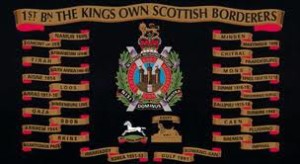 The 1st Battalion saw action in South Africa between 1900 and 1902. During World War 1 several new battalions were raised. The 1st Battalion fought on the Gallipoli Peninsula and on the Somme, Ypres, Lys and Cambrai. The 2nd Battalion served at Mons, Le Cateau, the Aisne, Ypres, the Somme, Vimy Ridge and Lys. The 4th and 5th Battalions fought at Gallipoli, and in Palestine and France. The 6th Battalion suffered heavy casualties at the Battle of Loos in 1915, and on the Somme, at Arras and at Ypres. The 7th and 8th Battalions lost much of their strength at Loos (where Piper Daniel Laidlaw famously won his VC for playing the regimental march 'All the Blue Bonnets are Over the Border' in defiance of enemy fire - see pic below); and were amalgamated in 1916 before fighting on the Somme and at Arras, Pilckem, and the Marne. Between the two World Wars the 1st Battalion served in India and Chanak (1922), and in Malta and Palestine (1936). The 2nd Battalion served in Ireland, Egypt, Hong Kong and India.
The 1st Battalion saw action in South Africa between 1900 and 1902. During World War 1 several new battalions were raised. The 1st Battalion fought on the Gallipoli Peninsula and on the Somme, Ypres, Lys and Cambrai. The 2nd Battalion served at Mons, Le Cateau, the Aisne, Ypres, the Somme, Vimy Ridge and Lys. The 4th and 5th Battalions fought at Gallipoli, and in Palestine and France. The 6th Battalion suffered heavy casualties at the Battle of Loos in 1915, and on the Somme, at Arras and at Ypres. The 7th and 8th Battalions lost much of their strength at Loos (where Piper Daniel Laidlaw famously won his VC for playing the regimental march 'All the Blue Bonnets are Over the Border' in defiance of enemy fire - see pic below); and were amalgamated in 1916 before fighting on the Somme and at Arras, Pilckem, and the Marne. Between the two World Wars the 1st Battalion served in India and Chanak (1922), and in Malta and Palestine (1936). The 2nd Battalion served in Ireland, Egypt, Hong Kong and India.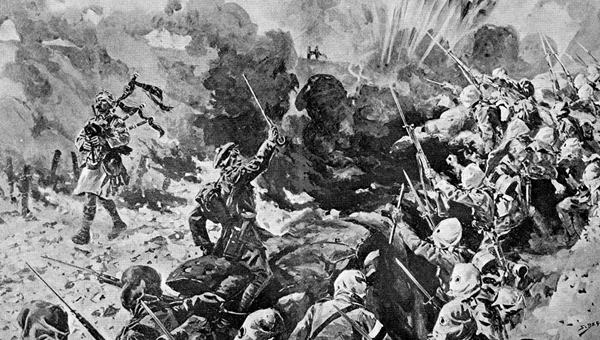
When World War 2 broke out in 1939 the 1st Battalion KOSB embarked for France. In May 1940 it crossed the Belgian border where it was forced to withdraw in view of enemy superiority in numbers. At the end of May the Battalion was evacuated from the beaches at Dunkirk, before returning to France on D-Day in 1944. It fought around Caen and then advanced north through Belgium and Holland to the Rhine and Bremen. The 4th and 5th (Territorial) Battalions also served in France in 1940 at St Malo before being evacuated from Cherbourg. These battalions subsequently trained as mountain troops and as air-transportable troops, before fighting on Walcheren Island at the mouth of the River Scheldt and then moving into Germany to take part in the capture of Bremen. The 6th Battalion was involved in fierce battles in Caen and the River Odon in 1944 before advancing into Germany ending the War beyond Hamburg. The 7th Battalion became glider-borne troops with the 1st Airborne Division, serving at Arnhem in 1944. The 2nd KOSB received jungle training and was posted to Burma in 1943.
Following World War 2 the 2nd, 6th and 7th Battalions were disbanded. The 1st Battalion served on security duties in Palestine between 1945 and 1947 before being posted to Korea for active service in 1951. Between 1955 and 1959 it was engaged in the jungle against communist terrorists. Between 1962 and 1964 it was on internal security operations in Aden. In 1965 it was in Borneo, patrolling the Malaysia/Indonesia border. From 1970 onwards the Battalion spent a great deal of time in Northern Ireland, the last tour being between 2004 and 2006. In 1991 the Battalion was deployed to the Gulf as part of Operation Granby/Desert Storm. There was also service in Belize (1978) and Cyprus (1999-2001). In 2003 the Battalion was deployed to southern Iraq to help maintain law and order in the aftermath of the overthrow of Saddam Hussein. In March 2006 the regiment became The Kings Own Scottish Borders Battalion as part of The Royal Regiment of Scotland. On 1 August 2006 the Royal Scots and KOSB Battalions merged to form The 1st (Royal Scots Borderers) Battalion of the new Regiment, now known as 1 SCOTS The Royal Scots Borderers.
• To follow: The Royal Highland Fusiliers, The Black Watch, the Argylls, the Scots Guards and the Royal Scots Dragoon Guards.













